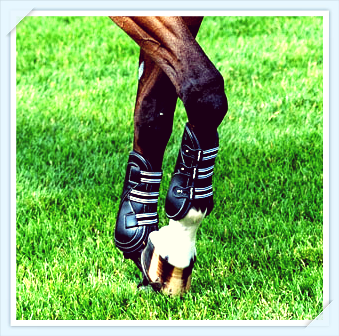Performance horses carry an immense amount of strength in their bodies, which translates to powerful and graceful movements that need to be protected with the right equipment. There is a lot of weight coming down on the thin legs of a horse, so when you ask them to work performing intricate dressage movements or jumping fences, you need to make sure you are protecting and supporting their legs the way you need to. Horse boots are used to protect from interference from other legs and potential puncture wounds or scrapes, as well as support tendons and ligaments from the shock of impact during riding or turnout.
While many horses, particularly those with big movements in their gaits, wear boots preventatively, it is especially important for those with prior injuries or prone to recurring injury in their legs. If you are considering purchasing new or replacement boots for your horse, here are a few selection points to keep in mind.
- Front or Hind – For many horses, it’s both. Horse boots will typically come in front or hind specific varieties. Ankle boots are the most popular style of hind boot, but full length boots can also be used. Many brands offer matching front and hind boot, with both designed for optimal shock absorption and strength to last through impacts.
- Category of Boot – Depending on what you do with your horse, different boots may suit your needs and style of riding better. Horse boots made of lightweight, strong material that will allow for ventilation and not absorb water are ideal for cross country jumping. Open front boots are typically used for stadium jumping and provide strike protection from opposite front and back legs, while leaving the front open to encourage the horse not to rub jump rails. Ankle boots are usually paired with these for the hind legs. Dressage boots offer a quicker, easier alternative to polo wraps and are typically lined with fleece or neoprene. Other support boots surround the leg entirely with a strap to cradle the fetlock joint and help prevent hyperextension. Finally, all purpose splint boots are great for horses that may likely hit themselves with their other legs, and feature a reinforced inner strike area.
- Material – There are a variety of materials to choose from when selecting the right horse boots. Neoprene is very easy-care and plastic boot exteriors are also simple to wash off. Leather boots are popular for a more upscale, show ring ready appearance. Fleece linings are very common, and are especially useful for support and protection if your horse has had a splint bone injury and needs that extra padding.
- Size – Most boots come in S, M, L, with some brands offering pony or XL sizes. While there are often sizing charts specific to manufacture, the height, weight, and breed of your horse combined with the circumference of its leg should give you an estimate for size. Smaller, refined breeds like Arabians or large ponies will likely be a small, while average height horses like Thoroughbreds will be mediums, and most Warmbloods will wear larges.
When you do select horse boots, make sure they fit properly by sliding one finger between the boot and the horse’s leg. It should feel snug but not squished. Also make sure the boot is not tall enough that it rises into the back of the horse’s knee and restricts movement. With the extensive horse boot selection out there, shopping for your horse’s new, stylish boots should be just as much fun as shopping for your own!

